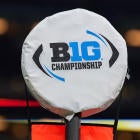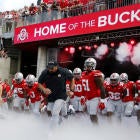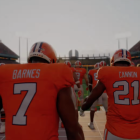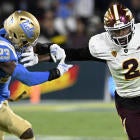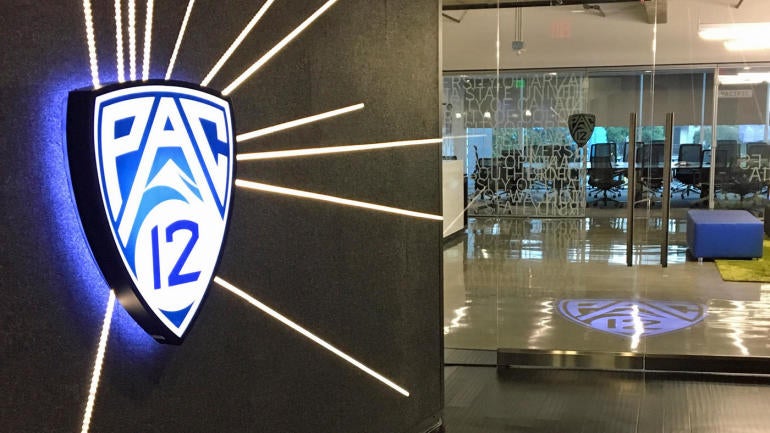
SAN FRANCISCO -- From everything we've heard, the Pac-12 offices should have solid gold toilets, gilded break rooms and marbled conference tables.
But on a recent visit to the league headquarters, it was clear the Conference of Champions has a problem with its reputational messaging.
The Pac-12 actually shares space in the building on Third Street between Folsom and Harrison. MLB.com is there, too. So is Comcast Sportsnet and NBC Bay Area, not to mention the Pac-12 Networks.
The league is more of a tenant than a palace-dweller in the South of Market district. Its digs are functional but not ostentatious -- more utilitarian than opulent. In other words, just about the norm you would expect in a Power Five HQ.
"I don't think there's anything different than some of the others," commissioner Larry Scott said.
That's where the similarities end. If it isn't already, the Pac-12 is about to slip to last place in earning power among its Power Five brethren. The bottom of the top of the food chain.
In these tenuous financial times, that means everything in college sports.
"We're like a lot of schools," Washington State athletic director Pat Chun said. "We're looking in couch cushions for money."
Pac-12 schools took home an average of $31 million in media rights revenue last fiscal. That sounds like a lot, but it's $19 million per year less than the Big Ten, $9 million per year less than the SEC. The Big 12 averages around $35 million, but with their third-tier rights, Texas and Oklahoma are taking home about $50 million annually each.
The ACC is ready to reap a windfall with the launch of its own network in August.
How does the disparity manifest itself out West? The list of underachievements keeps piling up.
- Pac-12 football just completed its 15th year without a national championship, the longest drought among Power Five conferences. The league has missed the most College Football Playoffs (three of five) among its peers.
- A season after being completely knocked out of the NCAA Tournament in the first weekend for the first time in 32 years, the Pac-12 may be a one-bid league this season.
- The much-maligned Pac-12 Networks have sunk to the point that Oregon State is making about as much annually from the network as it is paying one of its coordinators.
- Football attendance is down for the sixth straight season and at its lowest point since 1982. Games averaged 46,733 fans in 2018.
- Someone out there doesn't seem to like Scott being in office. A series of stories in the Oregonian has featured sensitive leaks and documents that only those on the inside could know about.
- The league continues to return the smallest percentage of revenue back to its members, at least among the Power Five. Scott's salary ($4.8 million) is more than the entire executive staff of the SEC ($3.7 million).
- The league recently contracted with the same public relations firm that gave us Spuds Mackenzie. The result was a 34-page brochure titled "Communications Strategy Development Project."
Yup, with all that under consideration, it turns out the league might have a problem with messaging, too.
"I can tell you this," said former Oregon AD Pat Kilkenny. "If Larry Scott is sitting on the other side of the table and there's an opportunity to sit [opposite of him], I'm going to sit next to him."
Kilkenny is not alone. Arizona State president Michael Crow is one of Scott's biggest supporters.
"To some extent, I don't really understand [the criticism]," Crow told the Arizona Republic last month. "What I mean by that is when I came here in this job 16 years ago, the conference had very little income, the conference was not highly capable of doing all the things we're now capable of doing."
The league has doubled down on what it calls a long-term play. A private equity offering -- first reported by the Oregonian -- would get some lucky investor 10 percent of the Pac-12 for $500 million.
If that sounds like a bit of "Shark Tank," you're right. Some person, firm or corporate entity would own one-tenth of a Power Five conference.
In return, the league would receive an infusion of cash to close that financial gap with other Power Five leagues.
The Pac-12 is looking for the equivalent of a shark like Mark Cuban buying into the Squatty Potty.
It also needs a Nick Saban. In the last two seasons, exactly one Pac-12 squad has finished with fewer than three losses. That would be Washington State, 11-2 in 2018.
The league's biggest battle right now might be one of perception. In this corner, things aren't as bad as they seem with a new media deal now only five years off. In the opposite corner is the best way out of this current mess: Just. Win. Games.
"For the Pac-12, if there is a board in front of them with a series of knobs involving the fortunes of the league, the biggest of those knobs is winning their games," said a veteran hedge fund manager asked by CBS Sports to break down a potential $500 million investment. "If they can turn that knob, they don't need to worry about the other knobs."
Scott is familiar with that take.
"If you're going through a down cycle like I think we are now in football and basketball, people try to look for reasons," Scott said. "I've been hearing that for 10 years. I've seen [down cycles] happen with the Big 12. I've seen it happen with the ACC. I've seen it happen with the SEC in basketball. I've seen it happen with the Big Ten. I think, in a way, it's our turn."
True, until Jim Harbaugh followed Urban Meyer into the Big Ten, that league went through its own perception problems. You've probably heard that the Big 12 can't play defense. The SEC is great until further notice. Thanks to Clemson, the ACC isn't just a basketball league anymore.
But none of them are making a $500 million cash call to make ends meet.
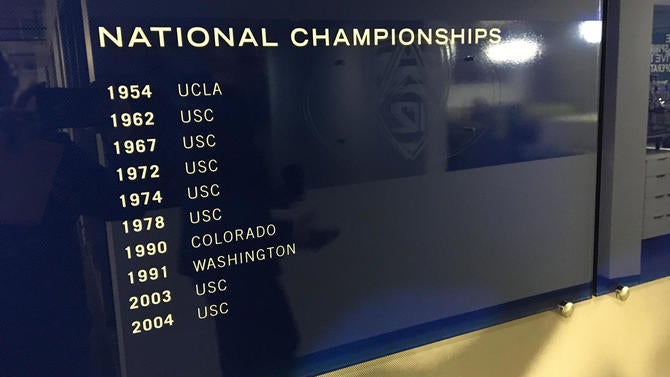
So how does a league that can't seem to get out of its own way, become rich(er)?
Dream big.
CBS Sports sought out that Wall Street expert to make sense of it all. The former hedge fund manager with more than a decade of experience said the economics are similar to winning the Powerball.
"Instead of waiting for the payments to be paid out, you take a lump sum," he said.
That's what the Pac-12 would be doing to goose a bottom line that is lagging. First, you have to assume there is a person or company out there willing to invest $500 million for the worst-performing Power Five football entity of recent times. Second, you better believe that investor would want a big return.
"Everyone is looking for investments that they can one way or another be less correlated with the stock market," said our expert, who preferred not to be identified.
The downside: The stock market can be as volatile as a coaching search. Up, down, fickle, no certainty. Unfortunately, that might be the perfect way to describe the Pac-12 at the moment.
Take the snapshot that is recruiting: Despite Oregon finishing fifth nationally in final 247Sports Composite team rankings, two of the Pac-12's traditional football powers underachieved. USC finished 20th overall, while UCLA was far lower at 41st.
"Anytime the banner carriers of the conference are down -- USC and UCLA -- that's going to kind of bring the whole conference down," said Barton Simmons, 247Sports director of recruiting. "The SEC had 11 of the top 23. Big Ten is revived with new coaches. Oklahoma and Texas are healthy in the Big 12. The ACC has Clemson. Contrasting the Pac-12 with the rest of the country, I think in recruiting … they're behind everyone else."
Recruiting is a foundation for any sport that has a time-release effect. It plays out over years. How will that dovetail with the equity offering that will play out over 15 years?
"College football is a product, just like Coke, just like Dr. Pepper, just like Ford cars," our financial expert said. "This is a product, and [the Pac-12 is] a company that has a product for sale. They may say it's not correlated with the market, but it really is."
The Oregonian report stated that, for the equity play, the Pac-12 will bundle all its entities -- network, conference rights, etc. -- into something called "Pac-12 NewCo." That's a holding company for the league's media rights. If that doesn't sound like a stock market abbreviation …
"I think the most interesting and impactful question to ask … is what is the exit strategy?" the expert said. "What is the liquidity event going to be because private equity guys are going to get their money back."
To summarize the reaction in college athletics, we take you to last season's College Football Playoff semifinal in at the Cotton Bowl. Shortly before kickoff, a high-powered college executive stopped short as he was walking across the back of an AT&T Stadium end zone. He was incredulous after reading the terms of the equity play on his phone.
"Jim Delany," that executive said of that league's commissioner, "values the Big Ten at $2 billion."
Do the math on that $500 million investment for a 10 percent stake, and the Pac-12 is valuing itself as a $5 billion enterprise. Our expert put its actual valuation at around $3.6 billion. That's still high compared any other conference.
"There's a big disconnect between what they're talking and what a fair valuation might be," he said. "[Scott] might say there's no other asset available like this on the market. I'd have a hard time [investing] when it's valued at two-and-a-half what the Big Ten and Big 12 are worth.
"If [Scott] thinks he's going to get top dollar for the piece of the business that he's selling, that's probably not going to happen. They're going to have to give up more than 10 percent [at a] $500 million valuation."
If so, that means there will a person or persons who would conceivably want more than a periodic conference call to update their investment. Sooner or later, it's fair to assume investors would want something close to day-to-day decision-making power.
The documents obtained by the Oregonian suggest that $500 million would be a 15-year investment and potentially be valued at more than $8 billion. The biggest near-term windfall would be 2025 when the Pac-12's current media rights deal with ESPN and Fox run out.
"Think about what Larry did by putting Fox and ESPN in the same deal together knowing they were strange bedfellows," Kilkenny said. "Fox and ESPN is something few people would attempt do to. Then, to get it done successfully."
Again, that message tends to be lost. That San Francisco office costs the league $7 million per year in rent. That's $7 million, critics say, that could go to Pac-12 athletic departments.
Compare that total compensation of the SEC executive staff ($3.7 million) to the total compensation of the Pac-12's top-five salaried employees ($8.4 million).
"Some of the schools have to do a better job of fundraising, quite frankly," Kilkenny said, "instead of sitting around complaining about the conference waving a magic wand and solving their problems."
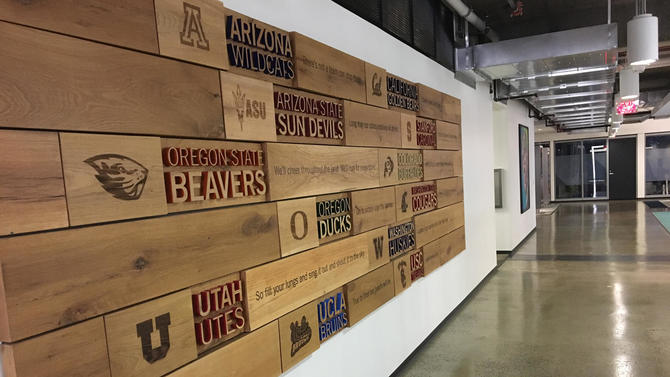
Like his commissioner peers, Scott is counting heavily on changes to the digital landscape by the time the current media deal runs out. None of those involved involved in the acronym FANG -- Facebook, Apple, Netflix and Google -- has shown significant interest in keeping college sports' revenue train rolling. Yet.
The partner of an investment firm hired to guide the Pac-12 through its next media rights negotiations sees the ability to "slice and dice" league sports.
Joe Ravitch of the Raine Group told the San Jose Mercury News that he envisions Colorado games being offered for $10 a month or Pac-12 basketball games available digitally in China.
"The over-the-top opportunities [cord cutting] are incredible," Kilkenny said.
The conference is basically borrowing against its future if the equity proposal works. Scott is not unlike his peers, banking on a future full of social media giants and cable-cutting technology merging into a new lucrative world of rights fees.
"He's trying to release some [future] value [of the conference] to the membership," Kilkenny said of Scott. "Each conference is different and has different priorities. Our conference, the Pac-12, you go to the stadiums on Saturday, they don't exactly look like Big Ten stadiums."
No, they don't. In fact, one of the biggest criticisms of the Pac-12 schools is that there are so many distractions for its fans. A bright sunny day in Southern California doesn't make fans necessarily think of rolling out to The Coliseum to see USC.
As one of the Pac-12's biggest influencers, Kilkenny is supremely confident of the league's future. The former Oregon student is one of Nike founder Phil Knight's closest confidants. Kilkenny is a noted San Diego-based insurance executive. He stepped in as Oregon AD from 2007-09.
"The beautiful part about all that is the conference has some of the most brilliant minds in the history of the world," Kilkenny said. "Larry isn't going to do anything without the buy-in from the leadership."
That leadership has been in flux. Eight of the current Pac-12 presidents have been on the job since July 2015. That's eight CEOs who weren't around when Scott was approved as commissioner in 2009.
Turnover in the Pac-12 means more than fumbles. There have been 32 football coaches, 28 presidents/chancellors, 28 athletic directors and 22 basketball coaches since Scott took office, according to the Mercury News.
According to numbers released by the Pac-12 last spring, the league distributed only 73 percent of its total revenue. That is thought be lowest percentage, by far, of any Power Five conference.
However, the rate is higher than it has been recently. Eyebrows were raised all over college athletics five years ago when the Pac-12 returned only 68 percent of its revenue to its members.
Typically, conferences return more than 90 percent of annual revenue to members.
If it takes money to make money in the Pac-12, then the Conference of Champions label fits. There were 516 national championships in the history of the league at last count.
Just not the right sports, lately.
"We have to be realistic," Scott said. "Winning creates an overall climate. If you're winning a lot and teams are doing great that certainly sets a tone and a message. If you're going through a down cycle, like I think we are now in football and basketball, people try to look for reasons."













